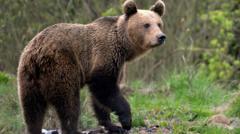In a tragic incident that underscores the dangers of human-wildlife encounters, a man has died after being attacked by a bear in Romania's picturesque mountain region along the Transfagarasan road. The incident occurred on Tuesday morning when the victim, an avid motorcyclist, made a stop at a well-known tourist spot. Authorities reported that the bear dragged him down a steep ravine, leading to a fatality. Ion Sanduloiu, the head of the Arges County Mountain Rescue Service, confirmed that the man was already deceased upon their arrival, despite wearing a helmet and protective gear.
The location where the motorcyclist stopped was marked with signs warning against feeding bears. Sanduloiu issued a stark warning, urging people to avoid stopping near bear habitats and prioritize safety by maintaining a distance from wildlife. Currently, the bear involved has not been euthanized, as investigations continue.
Romania has the largest population of brown bears in the European Union, and encounters between humans and bears have grown increasingly common. In response to several recent fatalities, calls for enhanced regulations and strategic investments to prevent such incidents have intensified. Recent studies suggest the Romanian brown bear population ranges from 10,400 to 12,800, substantially higher than earlier reports. Former environment minister Mircea Fechet indicated that an ideal sustainable population would be approximately 4,000 bears, advocating for streamlined regulations that would allow local authorities to respond more effectively to bears venturing into populated areas.
Additionally, the environment ministry has plans to develop risk zone maps to manage bear populations adequately while ensuring public safety. Conservationists point to systemic issues in Romania's wildlife management as the root cause of these recurring tragedies. Gabriel Paun, the founder of the NGO Agent Green, argued that the problem derives from poor governance, public misunderstanding, and insufficient action from authorities to minimize bear encounters.
As debates over wildlife conservation and public safety continue, Sanduloiu believes that enforcing stricter penalties, including hefty fines and potential prison sentences for those who actively feed bears, may help avert future losses.
The location where the motorcyclist stopped was marked with signs warning against feeding bears. Sanduloiu issued a stark warning, urging people to avoid stopping near bear habitats and prioritize safety by maintaining a distance from wildlife. Currently, the bear involved has not been euthanized, as investigations continue.
Romania has the largest population of brown bears in the European Union, and encounters between humans and bears have grown increasingly common. In response to several recent fatalities, calls for enhanced regulations and strategic investments to prevent such incidents have intensified. Recent studies suggest the Romanian brown bear population ranges from 10,400 to 12,800, substantially higher than earlier reports. Former environment minister Mircea Fechet indicated that an ideal sustainable population would be approximately 4,000 bears, advocating for streamlined regulations that would allow local authorities to respond more effectively to bears venturing into populated areas.
Additionally, the environment ministry has plans to develop risk zone maps to manage bear populations adequately while ensuring public safety. Conservationists point to systemic issues in Romania's wildlife management as the root cause of these recurring tragedies. Gabriel Paun, the founder of the NGO Agent Green, argued that the problem derives from poor governance, public misunderstanding, and insufficient action from authorities to minimize bear encounters.
As debates over wildlife conservation and public safety continue, Sanduloiu believes that enforcing stricter penalties, including hefty fines and potential prison sentences for those who actively feed bears, may help avert future losses.























